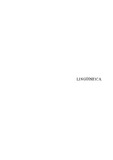Las marcas lingüísticas de obligación en artículos de investigación en tres disciplinas
Las marcas lingüísticas de obligación en artículos de investigación en tres disciplinas
| dc.creator | Briceño Velazco, Yosely | |
| dc.date.accessioned | 2015-06-16T22:33:26Z | |
| dc.date.available | 2015-06-16T22:33:26Z | |
| dc.date.issued | 2014-01-21 00:00:00 | |
| dc.identifier.citation | http://revistas.ucr.ac.cr/index.php/filyling/article/view/13086 | |
| dc.identifier.issn | ||
| dc.identifier.uri | https://hdl.handle.net/10669/14507 | |
| dc.description.abstract | Research articles evidence a variety of linguistic and discourse phenomena such as deontic modality which has to do with ‘must be’. As a theoretical background, proposals by Thompson (1996), who studies modulation, as well as Halliday’s (1994) have been used. Our purpose was to analyze the ‘must be’ in education, botany and engineering with a special focus on article sections. The main units of analysis were the research article and its sections and the corpus was comprised of 249.098 words. Findings show variation in terms of a percentage of 69.12 linguistic marks of obligation found in education, 26.17% in engineering and 4.69 in botany. In education, such marks tend to appear in the Introduction (38.25%) and in Results (17.11%). In botany they are found mostly in the Introduction (2.01%) and in Conclusions (1.34%). In engineering, they appear in the Methods section (9.39%) and also in the Introduction (6.71%). These findings suggest that the function of obligation tends to be determined both by the specific discipline and the section of the article in which it appears. | |
| dc.description.abstract | El artículo de investigación evidencia una variedad de fenómenos lingüísticos y discursivos, como la modalidad deóntica que se ocupa del ‘deber ser’. Tomamos como base teórica los planteamientos de Thompson (1996), quien estudia la modulación, al igual que Halliday (1994). Nos propusimos estudiar el “deber ser” en Educación, Botánica e Ingeniería, con atención especial en las secciones de los artículos. Se tomó como unidades mayores de análisis el artículo de investigación y sus secciones. El corpus fue de 249.098 palabras. Se encontró variación en cuanto a: un 69.12% de las marcas lingüísticas de obligación se hallaron en Educación sobre un 26.17%, en Ingeniería y 4.69% de Botánica. En Educación, dichas marcas se concentran en la Introducción (38.25%) y en los Resultados (17.11%). En Botánica se concentran en la Introducción (2.01%) y las Conclusiones (1.34%). En Ingeniería en el Método (9.39%) y también en la Introducción (6.71%). Los hallazgos sugieren que las funciones de la obligación están determinadas por la disciplina y la sección del artículo donde aparecen. | |
| dc.format.extent | - | |
| dc.relation.ispartof | Revista de Filología y Lingüística de la Universidad de Costa Rica Vol. 38 Núm. 2 | |
| dc.subject | discurso disciplinar | |
| dc.subject | discurso académico | |
| dc.subject | artículos de investigación | |
| dc.subject | modulación | |
| dc.subject | evaluación | |
| dc.title | Las marcas lingüísticas de obligación en artículos de investigación en tres disciplinas | |
| dc.title | Las marcas lingüísticas de obligación en artículos de investigación en tres disciplinas | |
| dc.type | artículo original | |
| dc.date.updated | 2015-06-16T22:33:26Z | |
| dc.language.rfc3066 | es |
Files in this item
This item appears in the following Collection(s)
-
Volumen 38, Número 2 [12]


